Not sure if this has already been done, but I decided last night that sleep is for sissies (as Zen Mod says) and thought I would update the Zen 4 with modern parts eg Jfet input for starters.
The original article is here. http://www.firstwatt.com/pdf/art_zv4.pdf
Changes made
1) Changed mosfets to IRFP240
3) Added cascoded Jfet input
Note:R15/R16 combo represents 5k trimpot
For the input I just pinched ideas from Nelson (as usual) aka ACA input but added cascode for 40V to 50V rails.
The feedback loop is not set in stone, if you need more gain, no problem change the resistor values.
Performance is very good, similar distortion to Aleph J.
Here is the circuit
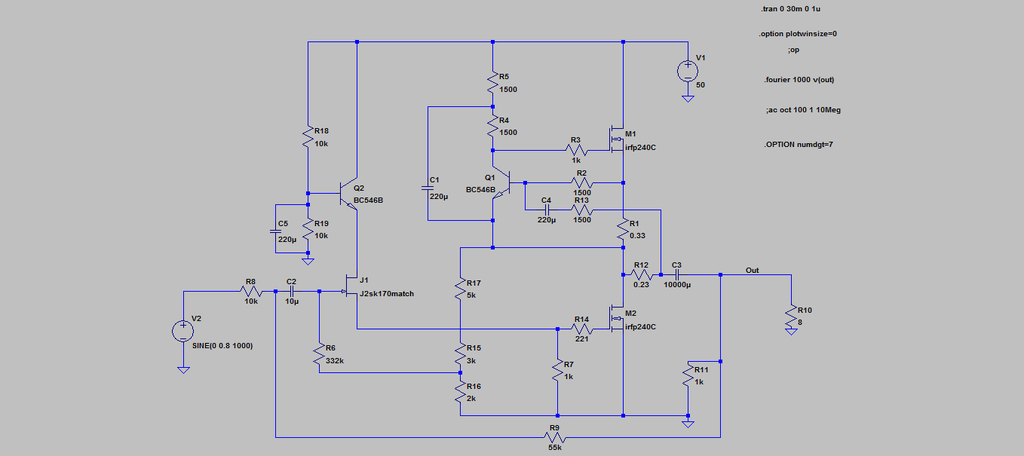
Here is the distortion at 1 Watt into 8 Ohms
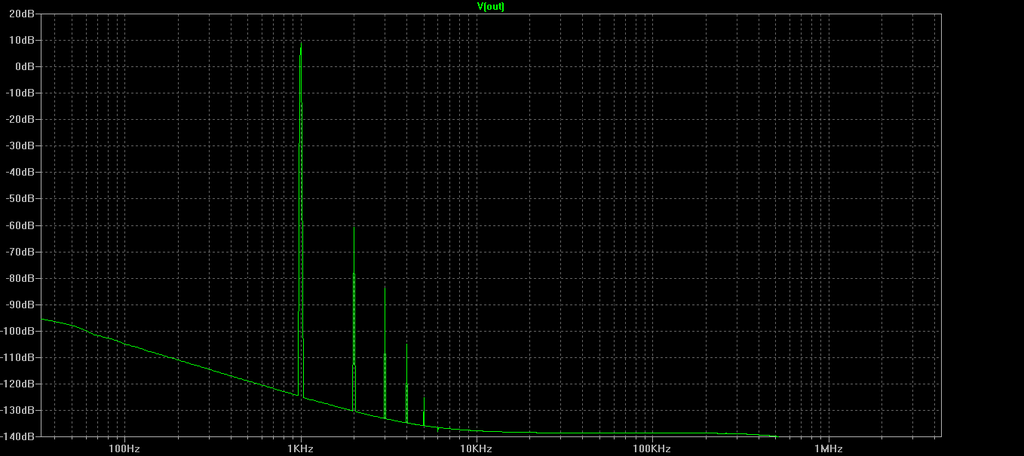
I might make further changes, but here is enough to get you started assuming someone out there might be interested in this.
The original article is here. http://www.firstwatt.com/pdf/art_zv4.pdf
Changes made
1) Changed mosfets to IRFP240
3) Added cascoded Jfet input
Note:R15/R16 combo represents 5k trimpot
For the input I just pinched ideas from Nelson (as usual) aka ACA input but added cascode for 40V to 50V rails.
The feedback loop is not set in stone, if you need more gain, no problem change the resistor values.
Performance is very good, similar distortion to Aleph J.
Here is the circuit

Here is the distortion at 1 Watt into 8 Ohms

I might make further changes, but here is enough to get you started assuming someone out there might be interested in this.
Last edited:
Do you know how this simulates with two Cree C3M0065090D SiC fets instead of the IRFP240?
Nice touch with the input Jfet.
Cheers,
Johannes
Nice touch with the input Jfet.
Cheers,
Johannes
I'll see what I can do.
It would be fair to say though that if they have similar amounts of transconductance, then most likely they may perform better with less distortion.
It would be fair to say though that if they have similar amounts of transconductance, then most likely they may perform better with less distortion.
Added C6. Actually fairly important to get a nice smooth roll off on the frequency response and avoid instability,
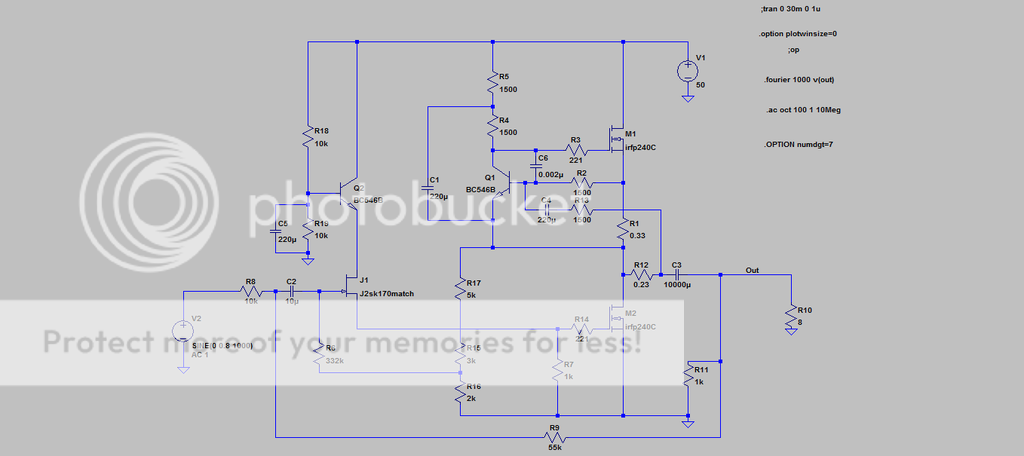

Added C6. Actually fairly important to get a nice smooth roll off on the frequency response and avoid instability,

Very nice Pico! Watch out for those lightning bolts from the CCS.....
With TO264 double die laterals it looks like this
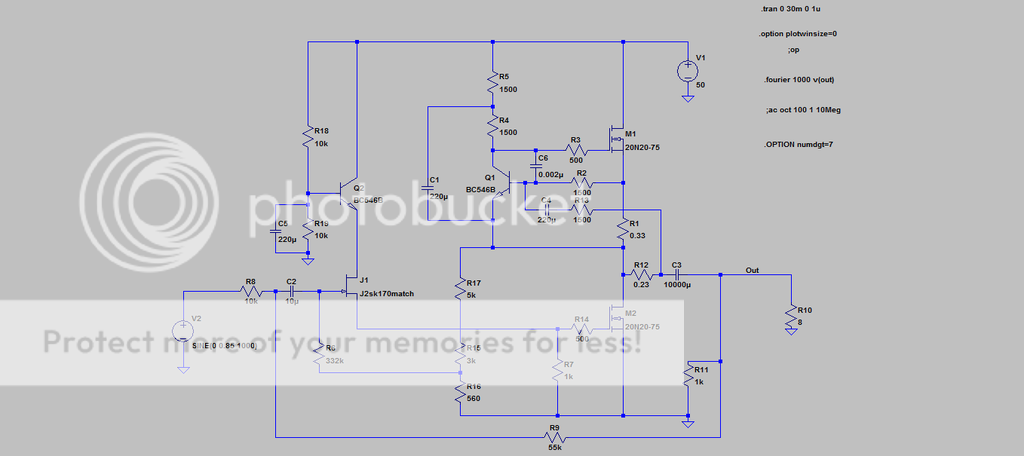
1 Watt distortion into 8 Ohms.
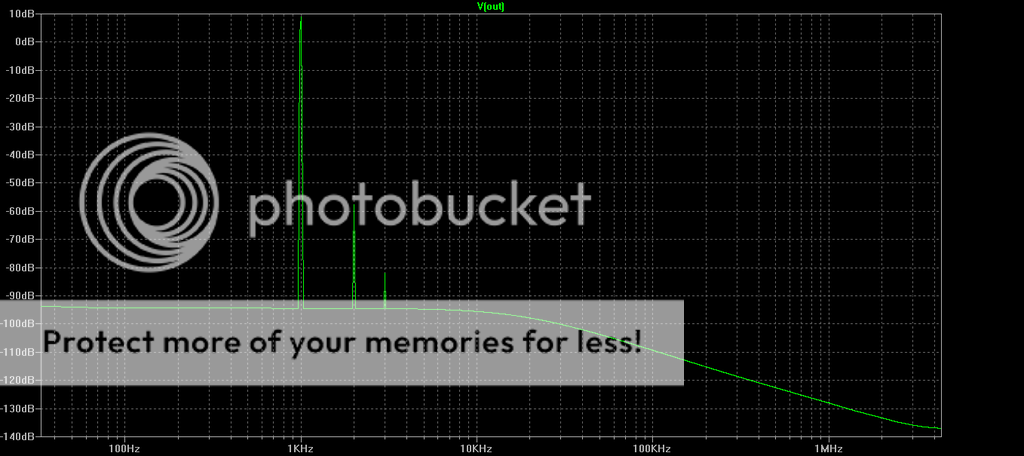
I'll get around to building it soon.

1 Watt distortion into 8 Ohms.

I'll get around to building it soon.
I nearly lost my remaining brain cell on this bloody spice model.Do you know how this simulates with two Cree C3M0065090D SiC fets instead of the IRFP240?
Nice touch with the input Jfet.
Cheers,
Johannes
Started with C2M0080120D
Gives more distortion but maybe the models are too "honest". Not sure what to believe. I think it would still sound great in practice (more toob sound)
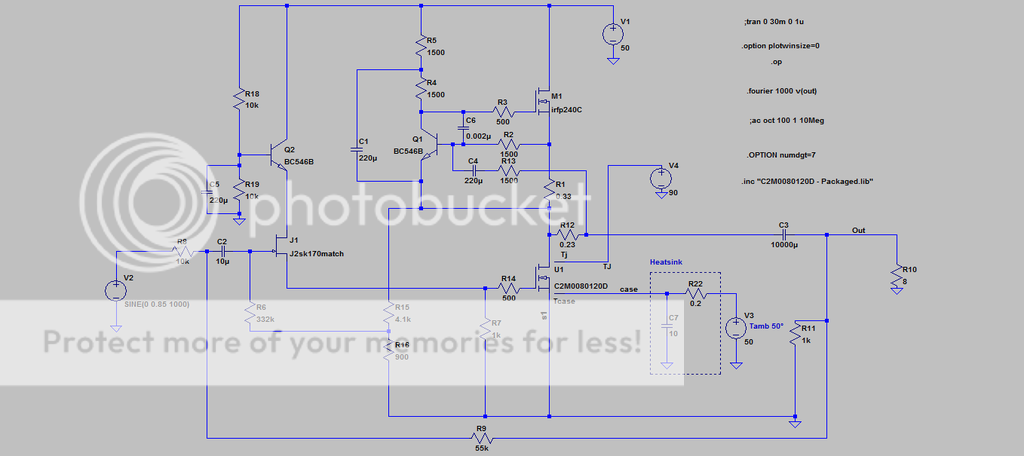
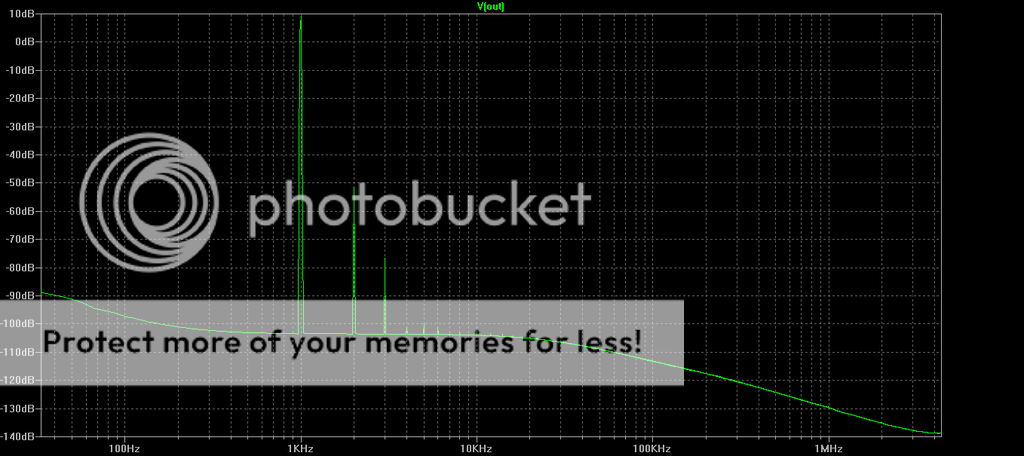
Not sure how realistic the junction temperature is but changing it +/- 10 degC only gives subtle differences nothing to get excited about.
Last edited:
Started with C2M0080120D
Gives more distortion but maybe the models are too "honest". Not sure what to believe.
I've wondered about the accuracy of Cree's published SPICE models for some time now. The C3M0065090D in particular exhibits considerably more distortion in the same circuits as the IRFP240 (with some minor adjustments for same bias and such), with IRF generally showing only 2nd and 3rd harmonic peaks, while C3M often shows peaks up to 6th harmonic. Simulated distortion in some circuits (e.g. the Aleph) with C3M can be orders of magnitude higher than IRF.
The only listening report of the C3M parts was done in an Aleph and the reported sound wasn't great, however some people reported good sound with the C2M parts. I have four of the C3M0065090D which were intended for an F6 (and were purchased before their model was released), but the report of sound quality in the Aleph and the almost 10x worse simulated THD (consisting of all odd harmonics to boot) has scared me off of using them. My F6 now sits unfinished until I can decide which outputs to use (C3M, IRF, or some Ixys parts I have).
Interestingly, the C3M simulates quite well as a cascode device sitting on top of an LU1014 in the ZenV9/F3.
Last edited:
I've wondered about the accuracy of Cree's published SPICE models for some time now. The C3M0065090D in particular exhibits considerably more distortion in the same circuits as the IRFP240 (with some minor adjustments for same bias and such), with IRF generally showing only 2nd and 3rd harmonic peaks, while C3M often shows peaks up to 6th harmonic. Simulated distortion in some circuits (e.g. the Aleph) with C3M can be orders of magnitude higher than IRF.
The only listening report of the C3M parts was done in an Aleph and the reported sound wasn't great, however some people reported good sound with the C2M parts. I have four of the C3M0065090D which were intended for an F6 (and were purchased before their model was released), but the report of sound quality in the Aleph and the almost 10x worse simulated THD (consisting of all odd harmonics to boot) has scared me off of using them. My F6 now sits unfinished until I can decide which outputs to use (C3M, IRF, or some Ixys parts I have).
Interestingly, the C3M simulates quite well as a cascode device sitting on top of an LU1014 in the ZenV9/F3.
I don't have the C3M models to test, have they been released now?
I've tested all of the C2M devices. The C2M080120D seems to be the sweetspot in a single stage amp out of the C2M models.
The C3M data sheets that I've looked at don't excite me as being better than C2M
For a 2 stage amp the choices probably open up a bit more.
Last edited:
I don't have the C3M models to test, have they been released now?
Only the C3M0065090D model has been released. I have posted it here and somewhere else on the forum (maybe in the SiC/SIT thread).
Are you looking at the C2M0080120D or the C2M0280120D? All of their part numbers are so similar.
Last edited:
I'm looking at C2M0080120D.
For a single pair C2M0080120D seems best (at least in simulation).
For multiple pairs C2M0160120D and C2M0280120D are certainly decent alternatives.
For a single pair C2M0080120D seems best (at least in simulation).
For multiple pairs C2M0160120D and C2M0280120D are certainly decent alternatives.
Last edited:
I've wondered about the accuracy of Cree's published SPICE models for some time now. The C3M0065090D in particular exhibits considerably more distortion in the same circuits as the IRFP240 (with some minor adjustments for same bias and such), with IRF generally showing only 2nd and 3rd harmonic peaks, while C3M often shows peaks up to 6th harmonic. Simulated distortion in some circuits (e.g. the Aleph) with C3M can be orders of magnitude higher than IRF.
The only listening report of the C3M parts was done in an Aleph and the reported sound wasn't great, however some people reported good sound with the C2M parts. I have four of the C3M0065090D which were intended for an F6 (and were purchased before their model was released), but the report of sound quality in the Aleph and the almost 10x worse simulated THD (consisting of all odd harmonics to boot) has scared me off of using them. My F6 now sits unfinished until I can decide which outputs to use (C3M, IRF, or some Ixys parts I have).
Interestingly, the C3M simulates quite well as a cascode device sitting on top of an LU1014 in the ZenV9/F3.
A bit of follow-up... I ended up playing around with the front end as much as I could (current, Vgs adjustments, etc.) and I just couldn't get enough bass. Eventually I gave up and put another set of 140's back in and... holy smokes. There was thunderous bass.. more than before. So I know that the changes I made could've helped the Cree part had the attribute existed, so to speak. In fact, it is so good now that I have left it the way it is, being that I enjoy trippy EDM and various Dub type music like "nightmares on wax". Quite simply, it shines in this area now more than ever.
BUT, since then.. Circlomanen has conjured some rather interesting ideas regarding positive feedback and that got me to thinking.. perhaps this C3M Cree part will have to be attempted in a 40V Zen circuit w/ pos feedback to improve the bass, because its mid/high performance was certainly better than IRFP. Alas, it's another project... slated behind my doing a 2sk180 L'amp. Too many parts, not enough time, and barely the intellect lol.
Only the C3M0065090D model has been released. I have posted it here and somewhere else on the forum (maybe in the SiC/SIT thread).
Are you looking at the C2M0080120D or the C2M0280120D? All of their part numbers are so similar.
I've had a chance to go back and check the data sheet for C3M0065090D.
It should perform better than C2M0080120D. If you have it, then it is certainly worth trying it out.
I'm having difficulty in getting the C3M model to work, but I'll keep trying.
I'm having difficulty in getting the C3M model to work, but I'll keep trying.
I ended up creating a specific custom schematic symbol called C3M0065090D which points to the model file in my sub folder. This worked fine, but trying to .inc the file and use the MOSFET symbol didn't, if I remember correctly.
Ok got the C3M0065090D model working.
Slightly higher distortion than C2M0080120D but better damping factor.
Not sure what to believe with these models, but if I had those devices the best way to find out would be to build one F6 channel with IRFP240 and one F6 channel with C3M. Do a direct comparison and let your ear be the judge then spend 30 minutes converting the losing amp channel to the winner, and you could be happy listening to music.
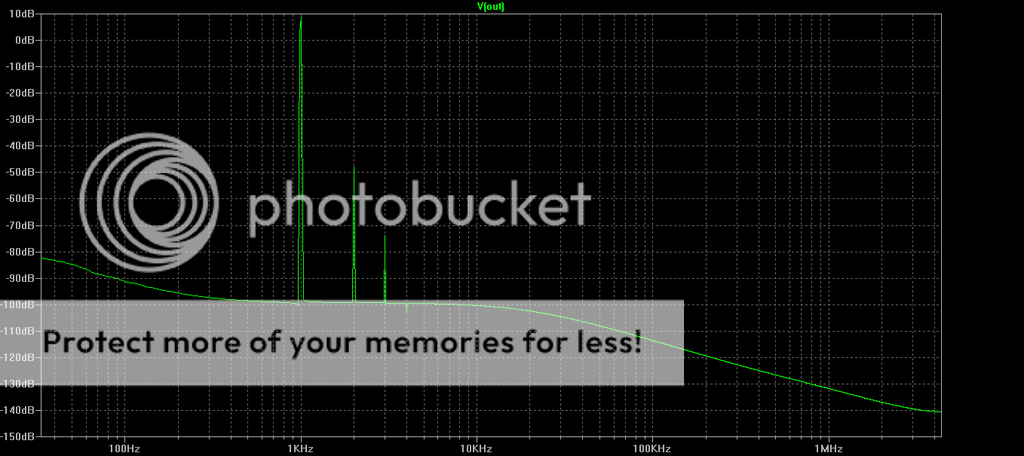
Slightly higher distortion than C2M0080120D but better damping factor.
Not sure what to believe with these models, but if I had those devices the best way to find out would be to build one F6 channel with IRFP240 and one F6 channel with C3M. Do a direct comparison and let your ear be the judge then spend 30 minutes converting the losing amp channel to the winner, and you could be happy listening to music.

Thanks for testing the Cree SiC fet in spice!
I must say that the Cree C3M0065090D behaves quite strange.
When I tried to match the fets over a 10 ohm resistor at about one ampere it had 9,3 volts Vgs and Vds for only 630 mA. I could not get any more current through the device without more voltage Vds.
They are 900 volt parts after all, and does not seem very happy with low voltages drain to source.
An IXYS IXTK100N25P happily ran 1,03 amperes with only 4,98 volts Vgs and Vds in the same setup just a few minutes earlier... ( I had a fun morning matching devices).
Cheers,
Johannes
I must say that the Cree C3M0065090D behaves quite strange.
When I tried to match the fets over a 10 ohm resistor at about one ampere it had 9,3 volts Vgs and Vds for only 630 mA. I could not get any more current through the device without more voltage Vds.
They are 900 volt parts after all, and does not seem very happy with low voltages drain to source.
An IXYS IXTK100N25P happily ran 1,03 amperes with only 4,98 volts Vgs and Vds in the same setup just a few minutes earlier... ( I had a fun morning matching devices).
Cheers,
Johannes
- Status
- Not open for further replies.
- Home
- Amplifiers
- Pass Labs
- The UPDATED Penultimate Zen 4